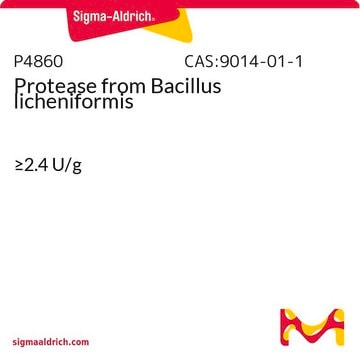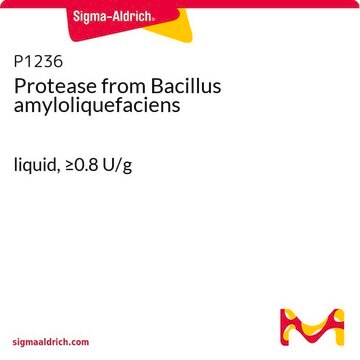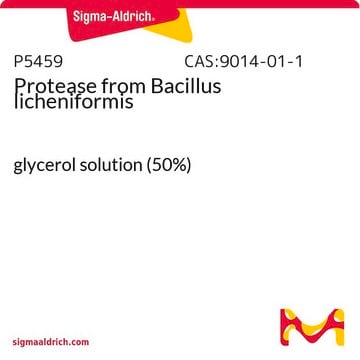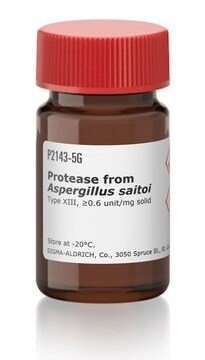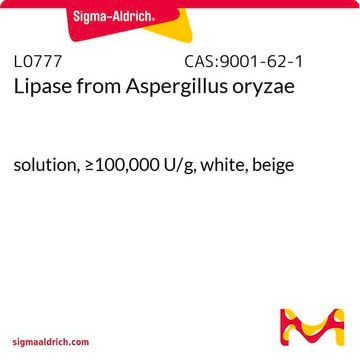P5985
Protease from Bacillus sp.
liquid, ≥16 U/g
Synonym(s):
Everlase 16.0 L
Sign Into View Organizational & Contract Pricing
All Photos(1)
About This Item
Recommended Products
biological source
Bacillus sp.
form
liquid
specific activity
≥16 U/g
mol wt
20--30 kDa
storage temp.
2-8°C
Looking for similar products? Visit Product Comparison Guide
Related Categories
General description
Proteases are ubiquitously found in nature and microbes are the desired source for these enzymes. They are classified into four classes namely aspartic, serine, cysteine and metalloproteases.
Application
Protease from Bacillus sp. has been used to determine its proteolytic activity by spectrophotometric method.
Biochem/physiol Actions
Protease catabolizes proteins by hydrolysis of peptide bonds. Proteases are inactivated by serine active-site inhibitors, such as phenylmethylsulfonyl fluoride (PMSF) and diisopropylfluorophosphate. Proteases, secreted from Bacillus sp., typically have molecular weights ranging from 20,000 to 30,000. They are typically stabilized by Ca2+ and have high isoelectric points. It is highly soluble in detergents at a wide range of pH and temperatures. Protease improves healing process by efficiently removing necrotic materials from wounds. It is extensively used in laundry detergents to remove protein based stains from clothing. In addition, protease is also used in food, pharmaceutical, leather and silk industries. It is a key constituent in biopharmaceutical products including contact-lens enzyme cleaners and enzymatic deriders. Proteases also aid in various physiological processes such as protein turnover, digestion, blood coagulation, fertilization and cell differentiation. It also facilitates growth, cell signaling, the immune response, and apoptosis.
Legal Information
A product of Novozyme Corp.
signalword
Danger
hcodes
Hazard Classifications
Aquatic Chronic 3 - Eye Dam. 1 - Resp. Sens. 1
Storage Class
10 - Combustible liquids
wgk_germany
WGK 2
ppe
dust mask type N95 (US), Eyeshields, Faceshields, Gloves
Certificates of Analysis (COA)
Search for Certificates of Analysis (COA) by entering the products Lot/Batch Number. Lot and Batch Numbers can be found on a product’s label following the words ‘Lot’ or ‘Batch’.
Already Own This Product?
Find documentation for the products that you have recently purchased in the Document Library.
Customers Also Viewed
Isolation, production and characterization of protease from Bacillus sp. isolated from soil sample
Josephine FS, et al.
Journal of Microbiology, 2(1), 163-168 (2012)
Irreversible inhibitors of serine, cysteine, and threonine proteases
Powers JC, et al.
Chemical Reviews, 102(12), 4639-4750 (2002)
Effect of UV light on microbial proteases: From enzyme inactivation to antioxidant mitigation.
Lante A, et al.
Innovative Food Science & Emerging Technologies, 17, 130-134 (2013)
Nicolas Buchon et al.
Proceedings of the National Academy of Sciences of the United States of America, 106(30), 12442-12447 (2009-07-11)
The Drosophila Toll receptor does not interact directly with microbial determinants, but is instead activated by a cleaved form of the cytokine-like molecule Spätzle. During the immune response, Spätzle is processed by complex cascades of serine proteases, which are activated
Sara Toja Ortega et al.
Water research X, 16, 100151-100151 (2022-08-16)
In aerobic granular sludge (AGS) reactors, granules of different sizes coexist in a single reactor. Their differences in settling behaviour cause stratification in the settled granule bed. In combination with substrate concentration gradients over the reactor height during the anaerobic
Our team of scientists has experience in all areas of research including Life Science, Material Science, Chemical Synthesis, Chromatography, Analytical and many others.
Contact Technical Service


